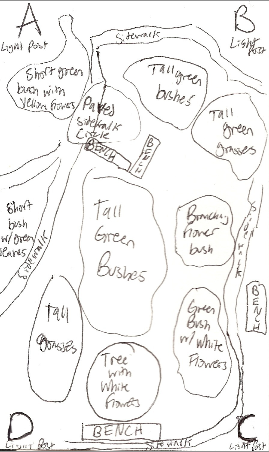User:Gabriel H Gan/Notebook/Biology 210 at AU
TA Alyssa Pederson MW 5:30-8:40PM 1 July 2014
Lab 1: Observing a Niche at AU
Introduction
The American University campus is saturated with different varieties of ecosystems. This lab notebook entry, the first in a series of three, will present and discuss observations from transect #3. Through this transect, it will be possible to study the biology of communities. The biodiversity, or number and type of species that live in an area, will be analyzed (Bentley 2014). In addition, living (biotic) and nonliving (abiotic) elements will be examined (Bentley 2014). Each species in the community has a niche that is important to the status of the community.
Transect #3 is located between Bender Arena, Hughes Hall, and the Woods-Brown Amphitheater. The coordinates are 38°56'16.2"N 77°05'20.4"W. The transect, approximately 20mx20m, has a collection of bushes, grasses, plants, and trees.
Figure 1: Map of Transect #3 Location on American University Campus

Transect #3 is located in between Bender Arena and Hughes Hall. Map from Google Maps.
Materials and Methods
Visual analysis was completed of transect #3. The transect was walked numerous times and observations on biotic and abiotic factors were recorded. A diagram of the plants and abiotic factors was sketched out. Photos were taken from an aerial view by standing on some of the benches. In addition to the photos taken from above, some were taken at standing height to record the survey of plants, trees and bushes.
Before leaving the transect, a soil and ground vegetation sample was taken. Back in the laboratory, this sample was mixed with Deer Park water and dried milk to make a hay infusion culture per lab manual instructions. The mixture was placed in an open jar and left out to be analyzed in the next lab.
Results
Below is a sketch diagram of the parts of the transect and numerous photographs. The transect is on flat, level ground with the exception of some small beds that are mound shape. In addition to the trees and plants noted, some small flying insects were present in the transect. The trees create a large amount of shady area.
Figure 2: Diagram of Biotic and Abiotic Components of Transect #3
- Note: Aerial photography was difficult due to tall nature of transect and inability to get to a place with a higher vantage point. Instead, multiple images were taken of the variety of elements in the transect.
Tables and Graphs
Table 1: Biotic and Abiotic Components of Transect 3
Discussions The purpose of this experiment was to explore the diversity in transcript #3. From initial observations, it appears that there are numerous types of plants and bushes present in the transect. It also appears that there are not many animals living in this transect. This may be due to the fact that the area is right next to the road and a busy part of campus that may not be conducive to undisturbed living.
The results of this initial exploration will be used to further the study of the many levels of organisms in the transect. By studying a small area with biodiversity, one can learn more about ecology.
References



